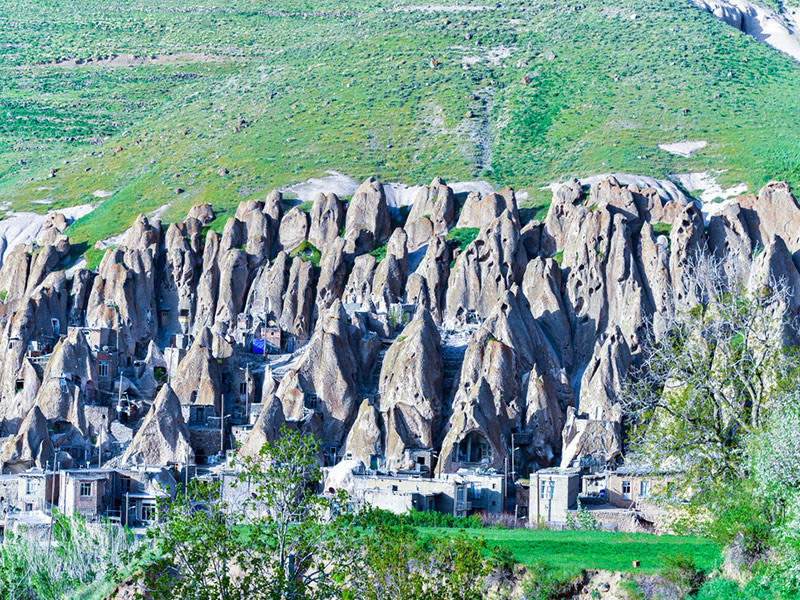Kandovan Village is located approximately 50 kilometers southwest of the city of Tabriz. This village is considered one of the most amazing villages in Iran. It is situated 18 kilometers south of the city of Osku, on the lush slopes of Mount Sultan Dagh. According to the latest national census, the village has a population of 601 individuals, residing in 137 households. The villagers are engaged in agriculture, animal husbandry, and handicrafts. Kandovan is famous for its unique rock formations, which resemble cone-shaped and nested pyramid-like houses. The residents of this village have created their homes, storages, and workshops within these rock structures.
Book Iran Air flights from London to Tehran and Tehran to London with Eligasht UK:
Reasons to Visit
- Kandovan, a village with an 800-year history, is one of the three remaining rock villages in the world.
- Kandovan is the only inhabited rock village in the world.
- The stone architecture of this village showcases the unique lifestyle of its residents.
- The villagers live in cone-shaped houses.
- Kandovan Village, with its unparalleled architecture, represents the way of life of the ancestors in this region.
Introduction to Kandovan Village
Kandovan Village is one of the most famous and astonishing natural and cultural tourist destinations in East Azerbaijan Province, Iran. Kandovan is the only “inhabited rock village” in the world. There are only two similar villages in the world, one in Cappadocia, Turkey, and the other in South Dakota, USA. However, the significant difference between these tourist attractions and Kandovan is that the former are uninhabited.
This historical village, with a history of over a thousand years, is situated in Osku County, 70 kilometers away from Tabriz. The beehive-shaped houses are located in the heart of the mountain in this village, resembling sugar cones.
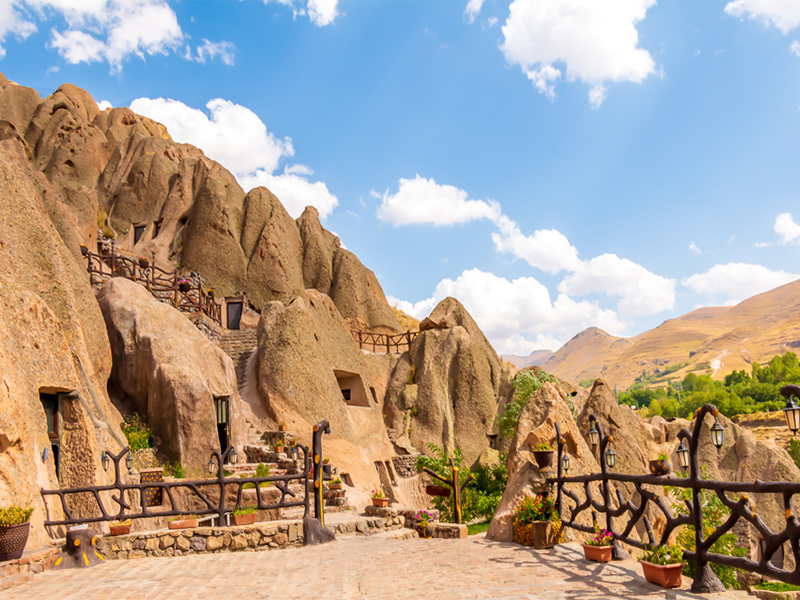
Interesting Features of Kandovan
One of the most fascinating features of Village is its geological wonder. The village is carved inside the rocks and volcanic formations that have shaped the region. For millions of years, the ash and volcanic remnants from Mount Sahand, an extinct volcano, have solidified and transformed into a soft and easily excavatable surface. The residents of Kandovan have taken advantage of this natural marvel and created their homes directly within the rocks, creating a unique and otherworldly landscape.
Kandovan is not just a historical remnant; it is a living village where the people have preserved their ancient traditions. The residents of Kandovan have made great efforts to maintain their unique way of life and distinctive architecture. They pass on the knowledge of stone carving from one generation to another, ensuring that this ancient skill is not lost over time.
Related post
Traveling to Tabriz, a city with a deep history and rich culture
Uncovering the Enchanting Tourist Attractions of Tabriz
History
The history of Kandovan Village is as captivating as its architecture. According to beliefs, the village has been inhabited for 700 years, and some sources even mention an older history. The roots of Kandovan Village are intertwined with the migration of Turkic tribes to this region, and the area has witnessed centuries of cultural exchange.
According to beliefs, the village was founded around the 13th to 14th century AD, although some archaeological studies estimate human settlement in the area as far back as 7,000 years ago. It is believed that a tribe called “Helevar,” fleeing from Mongol invasions, took refuge in the rock formations of Kandovan. Over time, Kandovan transformed into a permanent village that is still inhabited today.
Stone Architecture
The stone architecture of Kandovan is a testament to human’s struggle with nature and the utilization of natural rock formations. In conventional architecture, materials such as gypsum, lime, and clay form the main structure of buildings. However, in stone architecture, the desired spaces are created by excavating within rock masses and formations.
The houses in Kandovan Village are not merely homes; they are architectural wonders passed down from generation to generation. These houses are not only carved within the rocks, but they are also multi-story structures, often containing multiple rooms and even kitchens! The stone possesses the natural ability to regulate indoor temperatures, keeping the interiors cool in scorching summers and warm in cold winters, which remarkably optimizes energy consumption.
Interestingly, some of the houses in Kandovan Village have been transformed into comfortable guest accommodations, allowing visitors to experience the extraordinary rural life up close. Staying in one of these houses is like stepping back in time while still enjoying modern amenities.
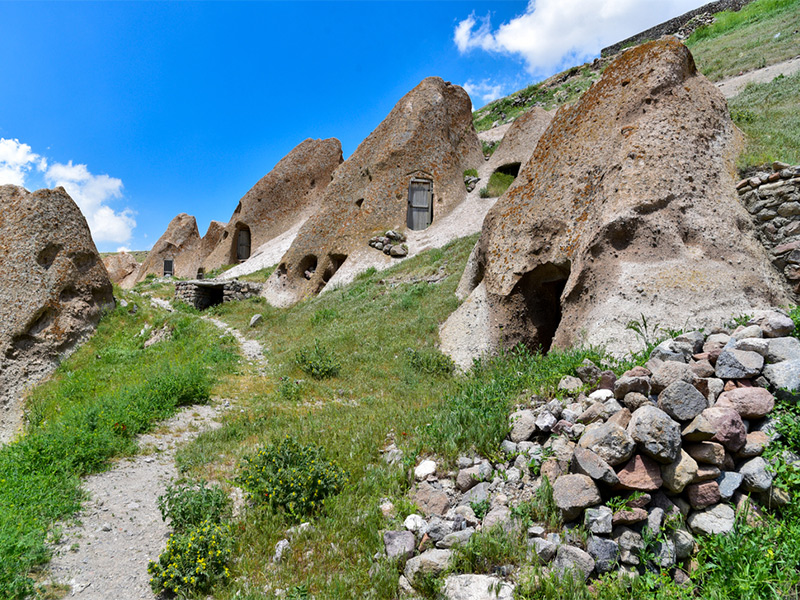
Formation of these astonishing rock structures
Due to volcanic interactions in the Sahand Mountains, a breathtaking landscape has emerged in one of the most beautiful and pleasant areas of Iran, resembling a dream. The erupting magma from the craters of Sahand volcano and other surrounding volcanoes has been flowing for thousands of years. These lavas have accumulated over centuries, gradually forming a rocky crust on top of them. Dozens of diverse, paired, individual, columnar, and flat shapes have created a masterpiece of the best natural scenery in Iran.
The flows and volcanic lavas have been shaped and restricted by winds and thousands of years of storms. Gradually, the softer parts have eroded, leaving behind the harder parts, resulting in the current extraordinary natural phenomenon. Intense wind and rain, especially in the entrance area of the village, have caused significant damage to these structures, while in the east and at the end of the village, due to the presence of tall mountains, the structures have remained more durable and intact. Kandovan includes a mosque, an Iranian public bathhouse, a school, and a mill. The houses, in general, are two-story, and in some cases, three or even four-story.
Exploring Kandovan Village
When walking through the narrow and winding streets of Kandovan village, you will not only find houses carved into the rocks. This village also showcases a beautiful landscape, accompanied by lush green gardens, flowing rivers, and towering mountains that create a prominent background. You can hike to the hilltops nearby to witness the breathtaking views of the village or have a picnic alongside the pristine streams that pass through the village center.
Kandovan is also known for its various handicrafts, including intricately woven carpets and rugs created by local artists. Visitors can observe these skilled artisans at work and even purchase their beautiful works as souvenirs.
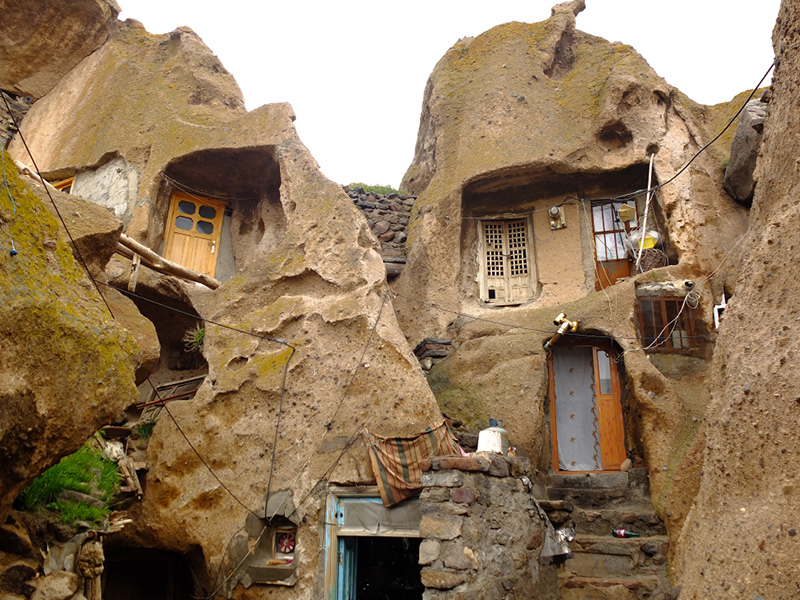
Other attractions in Kandovan
As mentioned, the unique architecture of Kandovan’s houses is not the only attraction in this region. Due to its geographical features, there are several hot springs with the lowest mineral pollution near this village, known for their therapeutic effects on diseases. Walking through the beautiful and verdant valleys, enjoying the pleasant weather, meeting friendly locals, witnessing panoramic sunsets, and tasting fresh organic honey and fruits produced in Kandovan have turned this village into an appealing destination for tourism in northwestern Iran. If you plan to travel to Tabriz, a visit to the authentic architecture and charming atmosphere of Kandovan must be included in your itinerary.
Kandovan and Cappadocia
Kandovan resembles a city in Turkey called Göreme, located in the Cappadocia region. However, one notable aspect of Kandovan is its liveliness, which is not the case for similar places in Turkey and the United States. Kandovan is one of the three rocky villages in the world, along with Cappadocia in Turkey and Dakota in the United States, that has gained such fame. But what distinguishes this village from its counterparts in other parts of the world is its liveliness and vibrancy. Here, despite all the difficulties and hardships, the inhabitants have never abandoned their ancestral village.
The best time to travel
While Kandovan Village in Tabriz is inhabited throughout the year, the best time to travel to this area is during the summer. Winter in Kandovan can be accompanied by heavy snowfall, which can make accessing the village or moving around it difficult.
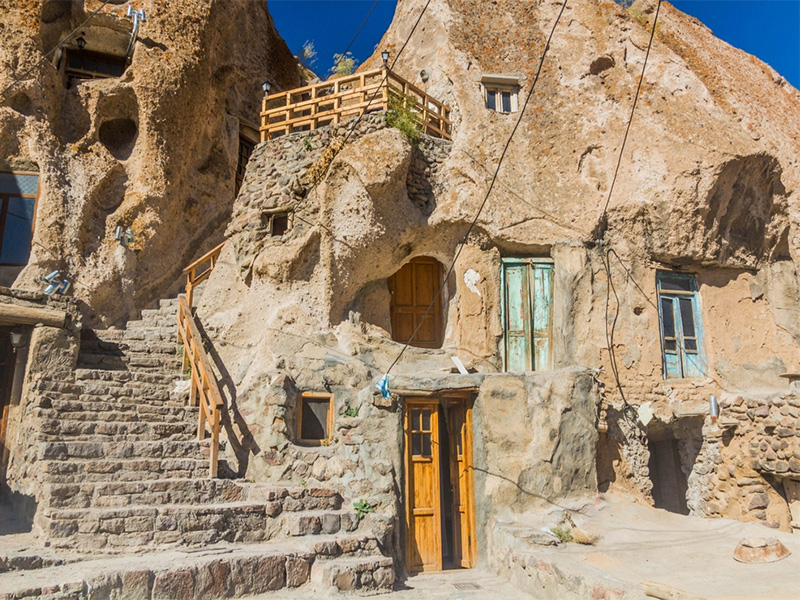
Access to Kandovan
this Village is located near the Sultan Dagh Mountains in East Azerbaijan Province, Iran. The nearest major city to this village is Tabriz. Kandovan is approximately 60 kilometers away from Tabriz (about a one-hour drive), making it an excellent destination for a day trip.
The easiest way to reach Kandovan is by car. There are also small buses that travel from Tabriz towards Osku, a city near Kandovan. These buses depart from the Train Square in Tabriz (slightly outside the city center). After reaching Osku, you can take a taxi or Kandovan bus to the village, which is a beautiful 20-minute journey amidst the rocky cliffs.
Products and Souvenirs
The main occupations of the residents of the rocky village of Kandovan are agriculture, livestock farming, and horticulture. They make a living by selling their own products and handicrafts. Among the agricultural products, wheat, barley, and chickpeas can be mentioned. The horticultural products of Kandovan include almonds, plums, apples, and other fruits that thrive in mountainous regions. In Kandovan, you can also find various popular handicrafts, including carpets and rugs.
Honey is one of the main souvenirs of Kandovan Village. Other souvenirs of this village include almonds, walnuts, and medicinal plants. The dried fruits of Kandovan are also delicious. In Kandovan, you can experience a variety of fresh dairy products for breakfast or other meals. Additionally, you can taste delicious local dishes such as Dizi, Tabrizi meatballs, and kebabs.
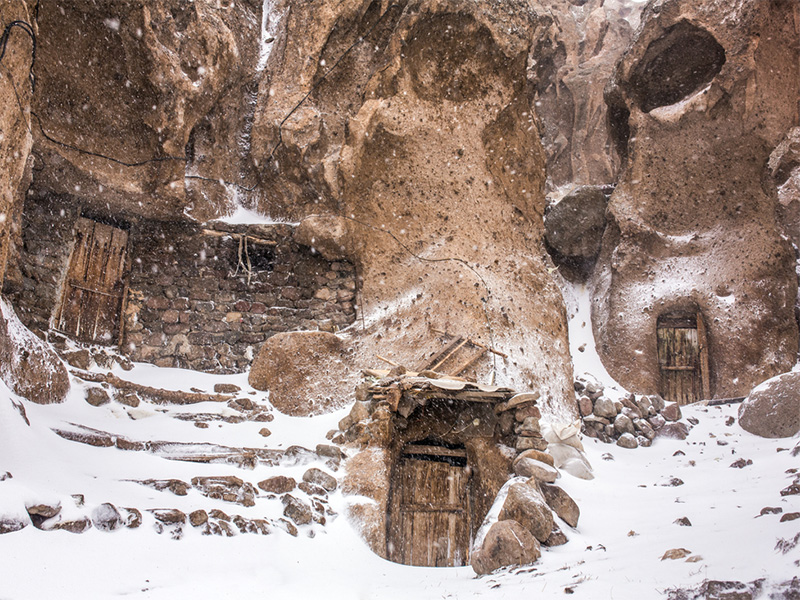
Staying in Kandovan Village
If you have decided to stay in Village, there are three options available to you:
Camping in the village: If you have the necessary equipment, you can have an enjoyable and memorable experience by camping in the nearby park. However, it’s important to note that nights in is can be very cold, so it’s better to bring warm clothing, even in the summer season.
Hotel: This option is suitable for those who want more facilities and a more organized stay. Laleh Kandovan Hotel is the only hotel available in this Village, offering amenities such as a buffet breakfast, a restaurant, and a café. This stone hotel, like other buildings, is constructed in the natural mountainous environment.
Eco-lodges: Those who want to experience the real life of the village’s people can stay in eco-lodges. Recently, eco-lodges such as Dariush, Homa, Sahand, and Aslani have received more recognition from tourists.
Final words
Kandovan in Persian is the plural form of “Kondoo” or “Zanbur,” which means beehive. The reason for this naming is that the houses in this area are built in the shape of beehives. The temperature in this area during the summer ranges from 13 to 27 degrees Celsius, which is considered cool in Iran and makes visiting Kandovan Village, especially in the summer season, one of the best tourism ideas in Iran.
FAQ
1- What is unique about Kandovan Village?
Kandovan Village is known for its unique rock-cut architecture, resembling beehives. The houses are carved into the volcanic rocks, creating a stunning and picturesque landscape.
2- How can I reach Kandovan Village?
Kandovan Village is located in the northwestern part of Iran, approximately 60 kilometers southwest of Tabriz. The village can be reached by road, and transportation options include private cars, taxis, or organized tours.
3- Are there any accommodations available in Kandovan village?
Yes, there are accommodations available in Kandovan village for visitors who wish to stay overnight. You can find traditional guesthouses and hotels that offer a comfortable stay amidst the unique rock-cut surroundings.
